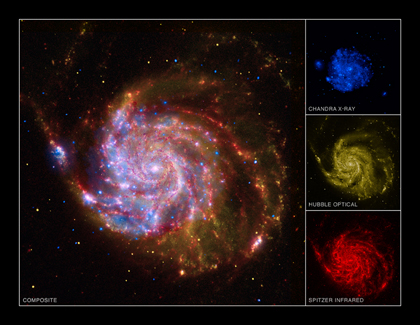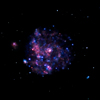For Release: February 10, 2009
NASA

Credit: X-ray: NASA/CXC/JHU/K.Kuntz et al.; Optical: NASA/ESA/STScI/JHU/K. Kuntz et al; IR: NASA/JPL-Caltech/STScI/K. Gordon
Press Image and Caption
In 1609, Galileo first turned his telescope to the heavens and gave birth to modern astronomy. To commemorate four hundred years of exploring the universe, 2009 is designated the International Year of Astronomy.
NASA's Great Observatories - the Hubble Space Telescope, Spitzer Space Telescope, and Chandra X-ray Observatory - are marking the occasion with the release of a suite of images at over 100 planetariums, museums, nature centers, and schools across the country in conjunction with Galileo's birthday on February 15.
The selected sites will unveil a large 9-square-foot print of the spiral galaxy Messier 101 that combines the optical view of Hubble, the infrared view of Spitzer, and the X-ray view of Chandra into one multi-wavelength picture. "It's like using your eyes, night vision goggles, and X-ray vision all at the same time," says Dr. Hashima Hasan, lead scientist for the International Year of Astronomy at NASA Headquarters in Washington.
Participating institutions also will display a matched trio of Hubble, Spitzer, and Chandra images of Messier 101. Each image shows a different wavelength view of the galaxy that illustrates not only the different science uncovered by each observatory, but also just how far astronomy has come since Galileo.
Messier 101 is a face-on spiral galaxy about 22 million light-years away in the constellation Ursa Major. It is in many ways similar to, but larger than, our own Milky Way galaxy. Hubble's visible light view shows off the swirls of bright stars and glowing gas that give the galaxy its nickname the Pinwheel Galaxy. In contrast, Spitzer's infrared-light image sees into the spiral arms and reveals the glow of dust lanes where dense clouds can collapse to form new stars. Chandra's X-ray picture uncovers the high-energy features in the galaxy, such as remnants of exploded stars or matter zooming around black holes. The juxtaposition of observations from these three telescopes provides an in-depth view of the galaxy for both astronomers and the public.
"The amazing scientific discoveries made by Galileo four centuries ago are continued today by scientists using NASA's space observatories," says Dr. Denise Smith, the unveiling Project Manager at the Space Telescope Science Institute in Baltimore, Md. "NASA's Great Observatories are distributing huge prints of spectacular images so that the public can share in the exploration and wonder of the universe."
The unveilings will take place between February 14 and 28 at 76 museums and 40 schools and universities in 39 states, reaching both big cities and small towns. Sites are planning celebrations involving the public, schools, and the local media. A complete listing of the national unveiling sites accompanies this press release.
The International Year of Astronomy Great Observatories Image Unveiling is supported by the NASA Science Mission Directorate Astrophysics Division. The project is a collaboration between the Space Telescope Science Institute, the Spitzer Science Center, and the Chandra X-ray Center.
Find out more about NASA's contributions to the International Year of Astronomy at:
http://astronomy2009.nasa.gov
Media contacts:
J.D. Harrington
Headquarters, Washington
202-358-5241
j.d.harrington@nasa.gov
Ray Villard
Space Telescope Science Institute, Baltimore, Md.
410-338-4514
villard@stsci.edu
Whitney Clavin
Jet Propulsion Laboratory, Pasadena, Calif.
818-354-4673
whitney.clavin@jpl.nasa.gov
Megan Watzke
Chandra X-ray Center, Cambridge, Mass.
617-496-7998
cxcpress@cfa.harvard.edu



